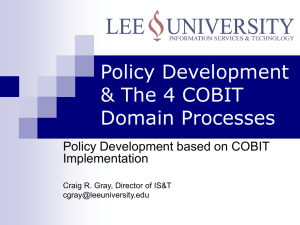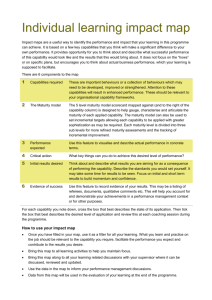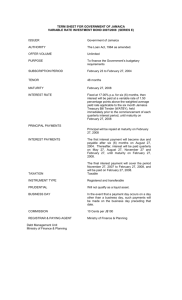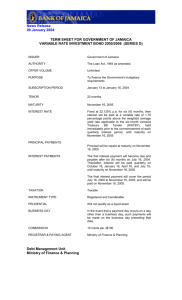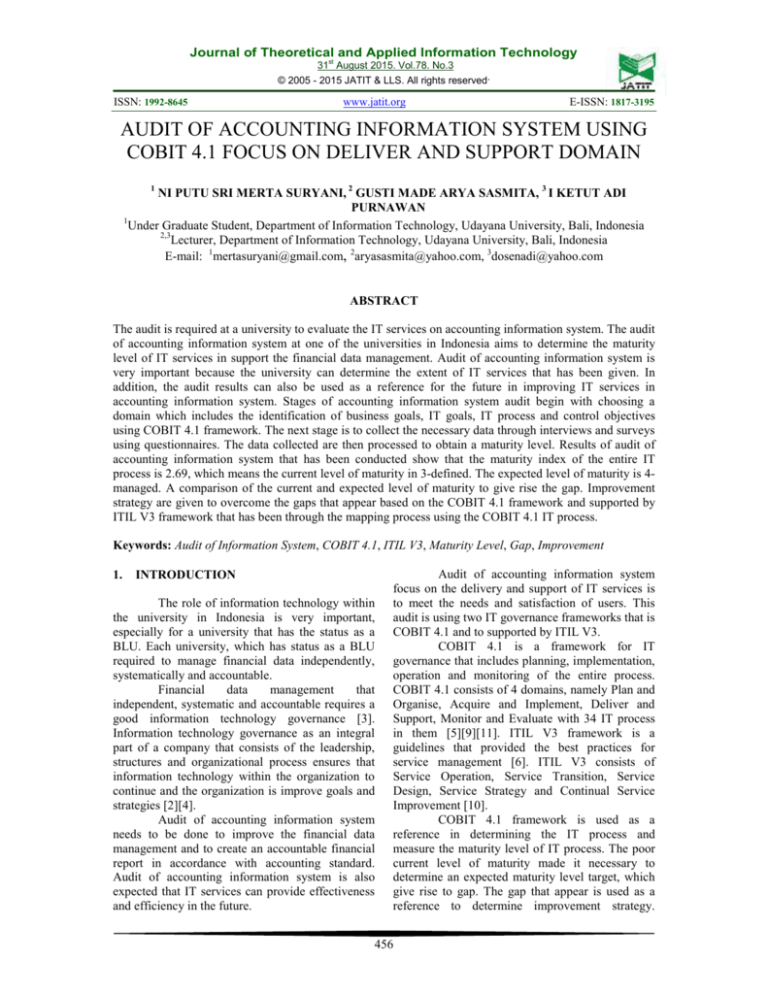
Journal of Theoretical and Applied Information Technology
31st August 2015. Vol.78. No.3
© 2005 - 2015 JATIT & LLS. All rights reserved.
ISSN: 1992-8645
www.jatit.org
E-ISSN: 1817-3195
AUDIT OF ACCOUNTING INFORMATION SYSTEM USING
COBIT 4.1 FOCUS ON DELIVER AND SUPPORT DOMAIN
1
NI PUTU SRI MERTA SURYANI, 2 GUSTI MADE ARYA SASMITA, 3 I KETUT ADI
PURNAWAN
1
Under Graduate Student, Department of Information Technology, Udayana University, Bali, Indonesia
2,3
Lecturer, Department of Information Technology, Udayana University, Bali, Indonesia
E-mail: 1mertasuryani@gmail.com, 2aryasasmita@yahoo.com, 3dosenadi@yahoo.com
ABSTRACT
The audit is required at a university to evaluate the IT services on accounting information system. The audit
of accounting information system at one of the universities in Indonesia aims to determine the maturity
level of IT services in support the financial data management. Audit of accounting information system is
very important because the university can determine the extent of IT services that has been given. In
addition, the audit results can also be used as a reference for the future in improving IT services in
accounting information system. Stages of accounting information system audit begin with choosing a
domain which includes the identification of business goals, IT goals, IT process and control objectives
using COBIT 4.1 framework. The next stage is to collect the necessary data through interviews and surveys
using questionnaires. The data collected are then processed to obtain a maturity level. Results of audit of
accounting information system that has been conducted show that the maturity index of the entire IT
process is 2.69, which means the current level of maturity in 3-defined. The expected level of maturity is 4managed. A comparison of the current and expected level of maturity to give rise the gap. Improvement
strategy are given to overcome the gaps that appear based on the COBIT 4.1 framework and supported by
ITIL V3 framework that has been through the mapping process using the COBIT 4.1 IT process.
Keywords: Audit of Information System, COBIT 4.1, ITIL V3, Maturity Level, Gap, Improvement
1.
INTRODUCTION
The role of information technology within
the university in Indonesia is very important,
especially for a university that has the status as a
BLU. Each university, which has status as a BLU
required to manage financial data independently,
systematically and accountable.
Financial
data
management
that
independent, systematic and accountable requires a
good information technology governance [3].
Information technology governance as an integral
part of a company that consists of the leadership,
structures and organizational process ensures that
information technology within the organization to
continue and the organization is improve goals and
strategies [2][4].
Audit of accounting information system
needs to be done to improve the financial data
management and to create an accountable financial
report in accordance with accounting standard.
Audit of accounting information system is also
expected that IT services can provide effectiveness
and efficiency in the future.
Audit of accounting information system
focus on the delivery and support of IT services is
to meet the needs and satisfaction of users. This
audit is using two IT governance frameworks that is
COBIT 4.1 and to supported by ITIL V3.
COBIT 4.1 is a framework for IT
governance that includes planning, implementation,
operation and monitoring of the entire process.
COBIT 4.1 consists of 4 domains, namely Plan and
Organise, Acquire and Implement, Deliver and
Support, Monitor and Evaluate with 34 IT process
in them [5][9][11]. ITIL V3 framework is a
guidelines that provided the best practices for
service management [6]. ITIL V3 consists of
Service Operation, Service Transition, Service
Design, Service Strategy and Continual Service
Improvement [10].
COBIT 4.1 framework is used as a
reference in determining the IT process and
measure the maturity level of IT process. The poor
current level of maturity made it necessary to
determine an expected maturity level target, which
give rise to gap. The gap that appear is used as a
reference to determine improvement strategy.
456
Journal of Theoretical and Applied Information Technology
31st August 2015. Vol.78. No.3
© 2005 - 2015 JATIT & LLS. All rights reserved.
ISSN: 1992-8645
www.jatit.org
Improvement strategy are determined based on the
COBIT 4.1 framework that is supported by ITIL V3
framework that has been through the mapping
process of the IT process in COBIT 4.1 framework
[7][12].
Audit of accounting information system
using two frameworks provided a better audit
results. In addition, weaknesses in accounting
information system can be seen in more detail by
using two frameworks that COBIT 4.1 and ITIL V3
[10].
Audit of accounting information system
using are COBIT 4.1 framework which is used to
measure the maturity level of IT services and ITIL
V3 as a support in recommendations for
improvement. The audit only focused on the 13 IT
process in Deliver and Support domain COBIT 4.1
framework. Deliver and Support domain is more
emphasis on the process of IT services, system
security, training, data management and other of the
accounting information system that has been used.
While some people have also been conducted audits
using IT governance frameworks such as COBIT,
ISO 27000, ITIL, COSO and others [5][6][10].
2.
AUDIT METHOD
The stages will be performed in audit of
accounting information system is shown in Figure
1.
Start
Audit Planning
Determining the Problem Formulation, Purposes
dan Problem Limitations
Review of Literature
University Data
Collection
E-ISSN: 1817-3195
The initial stage in planning an audit is to
determine the problem formulation, purposes and
problem limitations. In the planning stage, literature
study and university data collection are performed
to support the audit process. The next step is
selection of domain based on the COBIT 4.1
framework.
Selection of domain is conducted to
choose the IT process that will be used in the audit.
The IT process are obtained through the
identification of business goals, IT goals,
identification of IT process and identification of
control objectives according to the COBIT 4.1
framework.
Data collection is conducted through
interviews and surveys using questionnaires. Data
were obtained from interviews and surveys using
questionnaires then processed to obtain the maturity
level of IT process.
Then the obtained IT process maturity
level is analyzed. Afterwards the expected level of
maturity is determined to see the level of maturity
that has been achieved. Comparison of the current
maturity level with the expected maturity level give
rise to gap.
The gap that appears need to be overcome
to provide improvement strategy. It is a step to
achieve the expected level of maturity.
The providing of improvement strategy is
based on the COBIT 4.1 and ITIL V3 framework
that has been through the mapping process. After
giving the recommendation, then the final stage of
the audit process is the preparation of the final
report of the audit results.
Study of Literature
3.
AUDIT MODEL
Domain Selection
Bussiness Goal Identification
IT Goal Identification
IT Process Identification
Control Objective Identification
Data Collection
Survey using a
Questionnaire
Interview
Data Processing and Analysis
Expected Maturity
Level
Current Maturity Level
Maturity Gap
Improvement Strategy Based on ITIL V3 Framework
3.1. Questionnaire Draft of Maturity Level
Maturity
level
questionnaires
are
distributed to 29 respondents within the university.
The selected respondents are respondents who have
the duty and responsibility in the use of accounting
information system.
The statement was designed based on the
existing control objective in COBIT 4.1 IT process.
Each IT process control objective has statement that
describe how those controls are implemented and
maintained [11]. Table 1 shown an example of
control objective statement draft DS2.2 in IT
process DS2.
Preparation a Final Report of Audit Result
End
Figure 1: Stage of Audit Process
457
Journal of Theoretical and Applied Information Technology
31st August 2015. Vol.78. No.3
© 2005 - 2015 JATIT & LLS. All rights reserved.
ISSN: 1992-8645
www.jatit.org
Table 1: Example of Control Objectives Statement Draft
DS 2.2
initial, score of 2 means repeatable, a score of 3
means defined, score of 4 means managed, score of
5 means optimized. Score values being used refers
to the maturity level of the COBIT 4.1 framework
described in Table 4 [11].
Domain DS2 Managed Third-party Services
Control Objective DS2.2 – Supplier Relationship
Management
No
Statement
Value
The involvement of the system
developers, internal parties and users are
1
very close in creating a high value
system.
Table 4: COBIT 4.1 Maturity Level
Each respondent gives rating to the IT
process control objective statement that has been
determined. The rating of statements is necessary
because any such statements are not of equal value
in its application [1].
Level
0
(Nonexistents)
1
(Initial)
2
(Repeatable)
Table 2: The Rating of the Risk Assessment
Risk
High
Medium
Low
3
(Defined)
Value
0,7 – 1,0
0,4 – 0,6
0,1 – 0,3
The rating is determined from the
implementation guidelines and level of importance
to the organization. Statement that rated with high
risk mean that the statement is very important to be
done or implemented. Statement with medium risk
rating do not have the threat as big as the high, but
still need to be implemented as a precautionary
measure. Low risk is not required to be applied, but
if it is implemented will increase the performance
of system [1].
After making the statement, then questions
representing each control objective statement are
made. Each statement does not always produced
only one question, but it can be more than one as
long as these questions can represent each
statement [1][3]. Table 3 is contained question draft
example that represent a control objective statement
of DS2.2 in IT process DS2.
Table 3: Example of Question Draft Represent the
Control Objective Statement DS2.2
Domain DS2 Managed Third-party Services
Control Objective DS2.2 – Supplier Relationship
Management
Score
No
Question
0 1 2 3
1
In what extent is the
involvement of the system
developers, internal parties
and users in creating a high
quality system?
E-ISSN: 1817-3195
4
(Managed)
5
(Optimized)
Description
Organization knew nothing about the issue to be
solved. Each process or problem is not clearly
defined.
The organization already has proof in
identifying existing problems but needs to be
directed. There i no standard process and the
approach taken is ad-hoc.
Organization has a developed process. There is a
procedure to run a defined process, there is no
formal training and standard communication
procedures.
The organization already has a standardized and
documented procedure. The procedure has been
well communicated through formal training. But
at the implementation stage it depends on the
individual whether to follow the established
procedures or not. Procedure of the organization
is not yet perfect but it is a mere formality on
existing practice.
Organization monitors and measures the
procedures and policies that have been
effectively implemented. In the event of errors
and irregularities, a series of procedures for
corrective actions to be undertaken are already
exist. Repair are carried out consistently and
provide best practices and results. Automation
and tools are used limited and fragmented.
The conducted process has had improvement
efforts at the level of continuous best practices
that produces the best process and best results.
The use of integrated information technology is
already available there by automation can be
done within the organization. A tool to improve
the value and effectiveness is already exists thus
the organization can well adapt.
3.2. Measurement of Maturity Level
The results of the questionnaire data
processing are used as a benchmark to determine
the maturity level of IT process. In Table 5, COBIT
4.1 maturity level assessment criteria are shown
[11].
Table 5: COBIT 4.1 Maturity Level Assessment Criteria
4
Maturity Index
0 – 0,50
0,51 – 1,50
1,51 – 2,50
2,51 – 3,50
3,51 – 4,50
4,51 – 5,00
5
Each respondent provides an assessment
of the question that represents the control objective
statement by ticking (√) one score in accordance
with the opinion of the respondent. Score of 0
means non-existents, a score value of 1 means the
Maturity Level
0 – Non-existents
1 – Initial/ad hoc
2 – Repeatable but Intuitive
3 – Defined Process
4 – Managed and Measurable
5 – Optimized
The maturity level is determined in
accordance with the COBIT 4.1 framework that
provides company capability grouping in the
management of IT process from level zero (non-
458
Journal of Theoretical and Applied Information Technology
31st August 2015. Vol.78. No.3
© 2005 - 2015 JATIT & LLS. All rights reserved.
ISSN: 1992-8645
www.jatit.org
existent) to level five (optimized). Each maturity
level has a list of statements used as a guidelines in
assessing the extent to which the process takes
place in the company has fulfilled the statement
[8][11]. The maturity level calculation is described
as follows [1][2][6].
1. Calculation of the average value of each
statement (if the statement is more than one).
Total Rating =(Statement Rating 1)+( Statement Rating 2..n)
Total Statement
2. Calculation of the value score of each statement.
E-ISSN: 1817-3195
that consists of 13 IT process based on COBIT 4.1
framework.
4.2. Analysis of Current Maturity Level
Analysis of IT process maturity level on
Deliver and Support domain is conducted based on
the COBIT 4.1 framework to determine the current
level of maturity in the accounting information
system. The questionnaire calculation results for the
entire IT process distributed to 29 respondents can
be seen in Table 7.
Table 7: Current Maturity Level of IT Process
Total Score = (Question Score 1) + (Question Score 2...n)
IT Process
3. Calculation of the value score average of each
statement.
DS1 Define and Manage Service
Levels
DS2 Manage Third-party
Services
DS3 Manage Performance and
Capacity
Value Score = Total Score / Total Question
4. Calculation of the maturity level.
Maturity Level = (Total Rating) x (Value Score)
4.
DS4 Ensure Continuous Service
RESULT AND ANALYSIS
DS5 Ensure Systems Security
4.1. Determination of IT Process
Determination of IT process is performed
through several phases. The initial stage is to align
the vision, mission and purposes of the university in
implementing the accounting information system to
the business goals COBIT 4.1. Alignment
conducted in order to obtain business goals COBIT
4.1. COBIT 4.1 framework has 17 business goals
that are grouped based on the Balanced Scorecard
[11].
Next, the related IT goals are associated
with IT process contained in the COBIT 4.1
framework for obtaining IT process that will be
used in audits of accounting information system. In
Table 6 are shown the IT process used in the audit
process.
Table 6: IT Process being Used
IT Process
DS1
DS2
DS3
DS4
DS5
DS6
DS7
DS8
DS9
DS10
DS11
DS12
DS13
Description
Define and Manage Service Levels
Manage Third-party Services
Manage Performance and Capacity
Ensure Continuous Service
Ensure Systems Security
Identify and Allocate Costs
Educate and Train Users
Manage Service Desk and Incidents
Manage the Configuration
Manage Problems
Manage Data
Manage the Physical Environment
Manage Operations
Based on the selection of a domain that
has been done, an audit of accounting information
system focus on the Deliver and Support domain
DS6 Identify and Allocate Costs
DS7 Educate and Train Users
DS8 Manage Service Desk and
Incidents
DS9 Manage the Configuration
DS10 Manage Problems
DS11 Manage Data
DS12 Manage the Physical
Environment
DS13 Manage Operations
Maturity Level Average
Current Maturity
Value
Level
3-Defined
2,80
Process
3-Defined
2,67
Process
3-Defined
2,86
Process
3-Defined
2,75
Process
3-Defined
2,76
Process
3-Defined
2,52
Process
3-Defined
2,68
Process
3-Defined
2,71
Process
3-Defined
2,60
Process
3-Defined
2,61
Process
3-Defined
2,65
Process
3-Defined
2,76
Process
3-Defined
2,62
Process
3-Defined
2,69
Process
In Table 7 is shown that the average level
of maturity is 2.69 so that the condition of the
current level of maturity is in 3-defined. The
maturity level of 3-defined is a condition in which
the accounting information system already has
standardized and documented procedures. The
procedure has been well communicated through
formal training but at the implementation stage it
depends on the individual whether to follow the
established procedures or not.
4.3. Analysis of the Current and the Expected
Maturity Level
COBIT 4.1 framework has a measure of
maturity level ranging from 0 (non existents) to 5
(optimized) [8][11]. Target level of maturity IT
process gradually determined by looking the
current level of maturity that is in the 3-defined. It
459
Journal of Theoretical and Applied Information Technology
31st August 2015. Vol.78. No.3
© 2005 - 2015 JATIT & LLS. All rights reserved.
ISSN: 1992-8645
www.jatit.org
is also based on the purpose, vision and mission of
the university to be achieved in implementing the
accounting information system. Comparison of the
current level of maturity with the expected level of
maturity is shown in Table 8.
E-ISSN: 1817-3195
managed, thus causing the gap. Recommendations
for improvement should be provided to overcome
the that arise gaps so that the expected level of
maturity is the maturity level 4-managed can be
achieved.
Table 8: IT Process Gaps
IT Process
DS1 Define and Manage
Service Levels
DS2 Manage Third-party
Services
DS3 Manage Performance
and Capacity
DS4 Ensure Continuous
Service
DS5 Ensure Systems
Security
DS6 Identify and Allocate
Costs
DS7 Educate and Train
Users
DS8 Manage Service Desk
and Incidents
DS9 Manage the
Configuration
DS10 Manage Problems
DS11 Manage Data
DS12 Manage the Physical
Environment
DS13 Manage Operations
Maturity Level
Current
Expected
4
2,80
2,67
2,86
2,75
2,76
2,52
2,68
2,71
2,60
2,61
2,65
2,76
2,62
4.4. Improvement Strategy based on COBIT 4.1
and ITIL V3
Recommendations are provided to
overcome the gaps refer to the COBIT 4.1 and ITIL
V3 frameworks. Improvement strategy are also
supported by ITIL V3 framework through mapping
process using COBIT 4.1 IT process. COBIT 4.1
framework mapping with ITIL V3 is presented in
Table 9 [12].
Gap
1,20
4
1,33
4
1,14
4
1,25
4
1,24
4
1,48
4
1,32
4
1,29
4
1,40
4
4
4
1,39
1,35
1,24
4
1,38
Table 9: COBIT 4.1 and ITIL V3 Mapping
COBIT 4.1 IT Process
DS1 Define and Manage
Service Levels
Table 8 is shown that the expected level of
maturity is 4-managed. Maturity level of 4managed is a condition where it is possible to
monitor and measure compliance to procedures and
policies of accounting information system. If an
error occurs when using the accounting information
system, a series of procedures for improvement
actions to be undertaken is available. Improvement
are performed consistently and provides to
practices and best results.
Graphic representation of the current level
of maturity with the expected level of maturity is
shown in Figure 2.
Figure 2: Current and Expected Maturity Level Chart
The graph in Figure 2 is shown that the IT
process in the Deliver and Support domain are at
the current level of maturity is 3-defined and have
not reached the expected level of maturity in 4460
ITIL V3 Process
SD 4.2 Service level
management
SD 4.2.5.9 Develop
DS2 Manage Third-party
contracts and relationships
Services
SD 4.7 Supplier
management
SD 4.3 Capacity
management
DS3 Manage Performance
SO 5.1 Monitoring and
and Capacity
control (performance
monitoring)
SD 4.5 IT service
DS4 Ensure Continuous
continuity management
Service
SO 4.6.8 IT service
continuity management
SD 4.6 Information
security management
DS5 Ensure Systems
SO 5.13 Information
Security
security management and
service operation
SO 4.6.7 Financial
DS6 Identify and Allocate
management for IT
Costs
services
SO 5.14 Improvement of
DS7 Educate and Train Users
operational activities
DS8 Manage Service Desk
SO 4.2 Incident
and Incidents
management
DS9 Manage the
ST 4.3 Service asset and
Configuration
configuration management
SO 4.4 Problem
DS10 Manage Problems
management
SD 5.2 Data and
information management
DS11 Manage Data
SO 5.2.3 Backup and
restore
SD App E Environmental
DS12 Manage the Physical
architectures and standards
Environment
SO 5.12 Facilities and data
centre management
SO 5.1 Monitoring and
control
DS13 Manage Operations
SO 6.4 IT operations
management
Journal of Theoretical and Applied Information Technology
31st August 2015. Vol.78. No.3
© 2005 - 2015 JATIT & LLS. All rights reserved.
ISSN: 1992-8645
www.jatit.org
Based on the COBIT 4.1 and ITIL V3
frameworks mapping process, recommendations
will be given to overcome the gaps that arise so that
the expected level of maturity is in 4-managed can
be achieved. ITIL V3 framework is an IT
governance guidelines that provides the best
practices service management. Improvements
strategies towards maturity level 4-managed are
shown in Table 10 [11][13][14][15].
DS 05
Has the security policies
and
procedures
are
established
and
implemented effectively.
It is necessary for testing,
monitoring and reporting
to lead to improved levels
of security effectively.
Table 10: Improvements Strategies Based on COBIT 4.1
and ITIL V3
Improvements strategies
towards level 4 COBIT 4.1
DS 01
It is necessary to measure
and assess the IT services
based on defined criteria
effectively.
It is necessary for an
analysis of the causes of
the problems in the
service were not fulfilled.
DS 02
Has the policies and
procedures established to
manage the relationship
between services with
system
developers
effectively.
There is an agreement of
all the parties involved to
monitor the IT services
provided by the system.
DS 03
It is necessary to monitor
the performance and
capacity so that if not
enough can be overcome
with
established
procedures.
It is necessary for
reporting of performance
and capacity that is used
to support the passage of
effective IT services.
DS 04
Responsibility and plan of
IT service continuous
contained in the contract
that has been set.
Monitoring of IT services
effectively to ensure and
improve
IT
service
continuous.
DS 06
It
is
necessary
to
understand
the
accountability
of
IT
services costs.
Has the policies of IT
services cost allocation
are set so that the use of
funds does not deviate.
It is necessary for
monitoring and evaluating
the cost of IT services to
prevent
irregularities
costs.
Has the evaluation report
on the cost of IT services
effectively.
DS 07
Education and training are
performed effectively to
develop the IT services to
suit the user's needs and
developing technology.
It is necessary to classify
the
duty
and
responsibility of the user
to take part in education
and training.
It is necessary to monitor
the program are given in
the education and training
effectively.
Improvements strategies
towards level 4 ITIL V3
SD 4.2
There are plans to
increase IT services that
is run effectively.
There is policies and
procedures are always
followed.
There are SLA and OLA
are used as a guidelines
in managing IT service
levels.
SD 4.2.5.9 and SD 4.7
There are monitoring
results reported from
developer
system
effectively.
There are plans to run of
IT services to improve
the services to be
provided by the system
developer.
SD 4.3 and SO 5.1
There are a plans the
availability
of
performance
and
capacity are defined to
improve the IT services.
There are monitoring
and
reporting
the
availability
of
IT
services are conducted
to effectively.
SD 4.5 and SO 4.6.8
There are records about
the use of IT services
that serve as a reference
in ensure continuous
service.
There
is
a
risk
management according
to ITIL V3 framework.
There are policies and
procedures
for
continuous services.
There is a continuous
service plan to be
implemented in the
future to support the
improvement of IT
services.
DS 08
It is necessary to handle
the incident in accordance
of
established
responsibilities
and
standards.
It is necessary to train the
service desk staff to be
able to handle the
problem/incident
that
appears effectively.
DS 09
It is necessary for
monitoring, tracking and
reporting on configuration
file storage effectively.
461
E-ISSN: 1817-3195
SD 4.6
There are policies and
procedures
of
IT
security that must be
adhered and understood.
There is IT security
audit
be
done
effectively.
There is a setting user
access rights in IT
service management.
There is a security
testing of IT services.
SO 4.6.7
There
is
a
cost
allocation policies for IT
services that according
to user needs.
There are reports of the
use of IT service costs.
There is an evaluation of
the budgeted costs and
expenses that have been
used.
SO 5.14
There are measurements
through
operational
audits.
There is a responsibility
of each staff of the
given task.
There are problems
management that have a
lot of improvement
solutions.
There are education and
training that conducted
and
monitored
effectively.
There is a measurement
of the results of
education and training
which aims to enhance
education and training
in the future.
SO 4.2
There is a procedures to
identification
and
classification of the
incident/problem.
There are diagnosis and
investigation
of
IT
services to effectively.
ST 4.3
There is a configuration
management policies to
adhered and understood.
There are monitoring
Journal of Theoretical and Applied Information Technology
31st August 2015. Vol.78. No.3
© 2005 - 2015 JATIT & LLS. All rights reserved.
ISSN: 1992-8645
DS 10
Responsibility in solving
problems.
It
is
necessary
to
recording and reporting
identifying the problem
effectively.
It is necessary for the
integrated management of
problems
through
communication
among
staff involved in solving
problems.
DS 11
It is necessary to manage
data in accordance with
the
duties
and
responsibilities.
It is necessary to monitor
the management of data
such as back up and
restore data effectively.
DS 12
Has
the
security
procedures
of
environment and physical
that is used to control
access the environments
and hardware .
It is necessary to monitor
the environment and
physical access.
DS 13
It is necessary to monitor
the computing resources
and tasks assigned.
It
is
necessary
to
document the tasks and
schedules that are owned
by the staff to the
management of IT and
business can more easily
monitor the operations.
5.
www.jatit.org
and reporting to the
configuration
management.
SO 4.4
There is a detection of
problem according to
the standard ITIL V3.
There is a problem
categorization .
There are records of
problems that arise.
There is a detection of
problem during system
development.
E-ISSN: 1817-3195
measurement of the maturity level using is COBIT
4.1 framework. The maturity level of IT process is
at the maturity level of 3-defined and the expected
level of maturity is 4-managed to give rise the gap.
The improvement strategy given to overcome the
appear gaps are based on COBIT 4.1 supported by
ITIL V3 framework.
6.
FURTHER RESEARCH DIRECTION
The audit results are expected to be used
as a reference in developing and improving IT
services in accounting information system in the
future. The audit of accounting information system
in the future is also expected to not only focus on
IT process in the Deliver and Support domain but
also the entire IT process contained in the COBIT
4.1 framework. The expected maturity level must
also be increased to the maturity level of 5optimized which is the highest maturity level in the
COBIT 4.1 framework. The next audit it is also
expected to be able to use some of the IT
governance framework as comparison.
SD 5.2 and SO 5.2.3
There is a strategy to
restore and backup data.
There
is
the
responsibility of the
administrator to manage
the data.
There
is
a
data
management process to
manage data assets.
SD App E and ST 3.1
There
is
access
limitation
to
the
environment
and
physical .
There is agreement
against any person who
will
access
the
environment
and
physical.
There are monitoring
and reporting to the
environment
and
physical.
SO 5.1 and SO 6.4
There is a record of
operations carried out
effectively.
There are monitoring
and
recording
of
notifications that appear.
There is monitoring of
the operation so that if a
problem occurs can be
taken
improvement
action.
REFERENCES :
CONCLUSION
The conclusion of the audit that has been
done is an audit of the accounting information
system includes audit planning, the selection of the
domain consists of identifying the business goals,
IT goals, IT process and control objectives, data
collection, processing and analysis of data,
improvement strategy and preparation of an audit
results of final report. Audit of accounting
information systems focus on the domain Deliver
and Support with 13 IT process contained in it. The
[1] Uma Sekaran, “Metodelogi Penelitian Untuk
Bisnis”, Jakarta: Salemba Empat, 2006.
[2] Gondodiyoto, “Audit Sistem Informasi
Lanjutan”, Jakarta : Mitra Wacana Media.
2007.
[3] Sarno Riyanarto, “Audit Sistem dan
Teknologi Informasi”, Surabaya : ITS Press.
2009.
[4] HM Jogiyanto and Wily Abdilah, “Sistem
Tata
Kelola
Teknologi
Informasi”,
Yogyakarta : Andi. 2011.
[5] Maria Yulita Putu Dita, I Made Sukarsa and I
Ketut Adi Purnawan, “Assesment of COBIT
Maturity Level with Exixting Conditions from
Auditor”, International Journal of Computer
Science and Information Security (IJCSIS),
Vol. 10, No. 6, 2012.
[6] Diema Hernyka Satyareni and Fia Mahanani,
“Audit Sistem Informasi Akademik Perguruan
Tinggi XYZ Menggunakan Kerangka Kerja
COBIT 4.1”, Seminar Nasional Aplikasi
Teknologi Informasi (Yogyakarta), 2014.
ISSN: 1907-5022.
[7] Gusti Ayu Theresia Krisanthi, I Made Sukarsa
and I Putu Agung Bayupati, “Governance
Audit of Application Procurement Using
COBIT Framework”, Journal of Theoretical
and
Applied
Information
Technology
(JATIT), Vol. 59, No. 2, 2014.
462
Journal of Theoretical and Applied Information Technology
31st August 2015. Vol.78. No.3
© 2005 - 2015 JATIT & LLS. All rights reserved.
ISSN: 1992-8645
www.jatit.org
[8] I Gusti Ayu Dian Sasmita Ratih, I Putu Agung
Bayupati and I Made Sukarsa, “Measuring the
Performance of IT Management in Financial
Enterprise by Using COBIT”, I.J. Information
Engineering
and
Electronic
Business
(IJIEEB), Vol. 6 No. 1: 15-24, 2014.
[9] Riza Afriza Islami, I Made Sukarsa, I Ketut
Adi Purnawan, “Information Technology
Governance Archetype in an Indonesian
University”, TELKOMNIKA Indonesian
Journal of Electrical Engineering, Vol. 12, No.
7, 2014.
[10] Samir Bahsani, Abdelaali Himi, Hassan
Moubtakir and Alami Semma, “Towards a
Polling of ITIL V3 and COBIT”, International
Journal of Computer Science Issues (IJCSI),
Vol. 8, Issue. 6 No. 2, 2011. ISSN (Online):
1694-0814.
[11] IT Governance Institute Team, “COBIT 4.1”,
United States of America: IT Governance
Institute, 2007.
[12] IT Governance Institute Team, “COBIT
Mapping; Mapping ITIL V3 with COBIT
4.1”, United States of America: IT
Governance Institute, 2008.
[13] Office of Government Commerce (OGC),
“ITIL version 3 Service Design”, The
Stationery Office - TSO, London, 2007.
[14] Office of Government Commerce (OGC),
“ITIL version 3 Service Operation”, The
Stationery Office - TSO, London, 2007.
[15] Office of Government Commerce (OGC),
“ITIL version 3 Service Transition”, The
Stationery Office - TSO, London, 2007.
463
E-ISSN: 1817-3195


